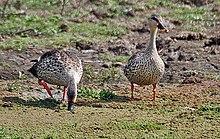Spotted duck
| Spotted duck | ||||||||||||
|---|---|---|---|---|---|---|---|---|---|---|---|---|

Spotted duck ( Anas poecilorhyncha ) |
||||||||||||
| Systematics | ||||||||||||
|
||||||||||||
| Scientific name | ||||||||||||
| Anas poecilorhyncha | ||||||||||||
| JR Forster , 1781 |
The spot- billed duck ( Anas poecilorhyncha ) is a species of bird from the genus of the actual swimming duck ( Anas ). This rather large and bulky duck species is native to Asia. It is widespread and numerous. There are three subspecies, which differ slightly in their body plumage. The name of the duck refers to two orange-red dots that are located on either side of the base of the beak.
Appearance
The body length of the spotted duck is 58 to 63 centimeters. The males weigh between 1230 and 1500 grams. Females are significantly lighter and weigh between 780 and 1360 grams.
Adult spotted ducks have brownish-black plumage, a white belly, and a white face. The duck's legs and feet are orange-red. The yellow front beak of the spotted duck is characteristic. In their appearance, the spotted ducks resemble the females of the mallard. They are spotted brown and yellow-brown, have a dark, clearly demarcated forehead and vertex, as well as an easily recognizable eye stripe. Females are distinguished by a less pronounced coloration of the plumage, otherwise the sexual dimorphism is only slightly pronounced. Both genders wear a year-round dress. So far there are no adequate studies of the moulting process.
The Chinese flat- billed duck ( Anas poecilorhyncha zonorhyncha ) is a bit brown and darker than the two subspecies that occur more south. It lacks the bright white stripe on the inner mirror edge, which is the most striking distinguishing feature of the other two subspecies. The two orange-red dots on the beak root that give it its name are also missing in this subspecies.
distribution
The spotted duck is found in Asia, especially in China , Mongolia , southern Siberia, Bangladesh , Cambodia , Laos , Vietnam , Burma and India .
The nominate form is native to the Indian subcontinent. Their distribution area extends in the south to Sri Lanka and in the east to Bangladesh, Assam and Manipur. The subspecies A. poecilorhyncha haringtoni , also known as the Burmese spotted duck , is native to Burma as well as southern China and Vietnam. It is believed to also be found in Laos, can also be found in Cambodia and reaches the extreme south of Vietnam. The Chinese flat- billed duck ( Anas poecilorhyncha zonorhyncha ) occurs in most regions of China. It also breeds in southern Siberia, Korea, and Japan.
The populations native to northern China, Mongolia, and Siberia are migratory birds. They move south in the winter months and then also reach Cambodia and Thailand. Stray visitors occasionally find themselves on the islands off Alaska and occasionally also reach the north of the Philippines.
For 2005 3–4 breeding pairs were reported from Germany, which were descended from breeding animals that had escaped. The species is considered an invasive species, according to the Federal Nature Conservation Act (BNatSchG) § 40, which endangers native species. Elimination is required for Germany so that no larger populations build up.
habitat
Red-billed ducks prefer shallow freshwater bodies of water and swamp areas, which have very dense underwater vegetation. They are only occasionally at rivers. The Chinese spotted duck is also found in coastal waters. However, spotted ducks seem to generally avoid brackish water or even salt water. In regions where the mallard is also found, they rarely occur together. This is taken as an indication that the spotted duck has different requirements for its habitat than this species.
Way of life
The behavior of the spotted duck is very similar to the mallard . It lives in small flocks and in family groups, preferably in shallow, swampy waters. She searches carefully for her food. Their diet is predominantly vegetable and the spotted duck can also often be found in rice fields. In Japan it is even the only species of duck that regularly breeds in or on rice fields. The spotted duck feed mainly on vegetable matter. They eat green water, shore and land plants, but also seeds , fruits , insects , tadpoles , spawn, small fish , frogs and worms .
Reproduction
The mating season is spring. The spotted ducks build their nests out of plants on an embankment. The females incubate once a year and lay 8 to 14 eggs . The breeding season is between May and December and is 26 to 28 days. There are currently insufficient studies on the average breeding success, the development of the chicks and young birds. It is assumed, however, that newly hatched chicks fledged after 49 to 56 days.
Subspecies
- A. poecilorhyncha haringtoni (Oates, 1907) (Burmese spotted duck)
- A. poecilorhyncha poecilorhyncha (Indian spotted duck )
- A. poecilorhyncha zonorhyncha (Swinhoe, 1866) (Chinese spotted duck, sometimes also called Eastern spotted duck)
supporting documents
literature
- Janet Kear (Ed.): Ducks, Geese and Swans. Oxford University Press, 2005, ISBN 0-19-854645-9 .
- Hartmut Kolbe; Die Entenvögel der Welt , Ulmer Verlag 1999, ISBN 3-8001-7442-1
- John Gooders and Trevor Boyer: Ducks of Britain and the Northern Hemisphere , Dragon's World Ltd, Surrey 1986, ISBN 1-85028-022-3
Web links
- Spotted duck. wasserziergefluegel.de, archived from the original on September 28, 2007 ; Retrieved September 9, 2012 .
- Avibase entry Fleck-billed duck ( Anas poecilorhyncha ) Forster, JR, 1781
- Videos, photos and sound recordings of Anas poecilorhyncha in the Internet Bird Collection
- Anas poecilorhyncha inthe IUCN 2013 Red List of Endangered Species . Listed by: BirdLife International, 2013. Retrieved February 2, 2014.

